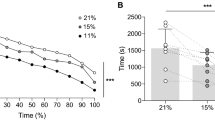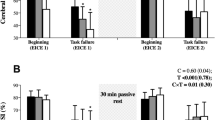Abstract
The ability to modify power output (PO) in response to a changing stimulus during exercise is crucial for optimizing performance involving an integration system involving a performance template and feedback from peripheral receptors. The rapidity with which PO is modified has not been established, but would be of interest relative to understanding how PO is regulated. The objective is to determine the rapidity of changes in PO in response to a hypoxic challenge, and if change in PO is linked to changes in arterial O2 saturation (S aO2). Well-trained cyclists performed randomly ordered 5-km time trials. Subjects began the trials breathing room air and switched to hypoxic (HYPOXIC, FIO2 = 0.15) or room (CONTROL, FIO2 = 0.21) air at 2 km, then to room air at 4 km. The time delay to begin decreasing S aO2 and PO and to recover S aO2 and PO on to room air was compared, along with the half time (t 1/2) during the HYPOXIC trial. Mean S aO2 and PO between 2 and 4 km were significantly different between CONTROL and HYPOXIC (94 ± 2 vs. 83 ± 2% and 285 ± 16 vs. 245 ± 19 W, respectively). There was no difference between the time delay for S aO2 (31.5 ± 12.8 s) and in PO (25.8 ± 14.4 s) or the recovery of S aO2 (29.0 ± 7.7 s) and PO (21.5 ± 12.4 s). The half time for decreases in S aO2 (56.6 ± 14.4 s) and in PO (62.7 ± 20.8 s) was not significantly different. Modifications of PO due to the abrupt administration of hypoxic air are related to the development of arterial hypoxemia, and begin within ~30 s.


Similar content being viewed by others
References
Albertus Y, Tucker R, St. Clair Gibson A, Lambert EV, Hampson DB, Noakes TD (2005) Effect of distance feedback on pacing strategy and perceived exertion during cycling. Med Sci Sports Exerc 37:461–468
Amann M, Eldridge MW, Lovering AT, Stickland MK, Pegelow DF, Dempsey JA (2006a) Arterial oxygenation influences central motor output and exercise performance via effects on peripheral locomotor muscle fatigue in humans. J Physiol 573:937–952
Amann M, Romer LM, Pegelow DF, Jacques AJ, Hess CJ, Dempsey JA (2006b) Effects of arterial oxygen content on peripheral locomotor muscle fatigue. J Appl Physiol 101:119–127
Ansley L, Schabort EJ, St. Clair Gibson A, Lambert MI, Noakes TD (2004) Regulation of pacing strategies during successive 4-km time trials. Med Sci Sports Exerc 36:1819–1825
Arbogast S, Vassilakopoulos T, Darques JL, Duvauchelle JB, Jammes Y (2000) Influence of oxygen supply on activation of group IV muscle afferents after low-frequency muscle stimulation. Muscle Nerve 23:1187–1193
Borg G (1998) Borg’s perceived exertion and pain scales. Human Kinetics, Champaign, IL
Craig AD (2002) How do you feel? Interoception: the sense of the physiological condition of the body. Nature Rev Neurosci 3:655–666
Dempsey JA, Wagner PD (1999) Exercise induced arterial hypoxemia. J Appl Physiol 87:1997–2006
Eston R, Falulkner J, St Clair Gibson A, Noakes T, Parfit G (2007) The effect of antecedent fatiguing activity on the relationship between perceived exertion and physiology activity during a constant load exercise task. Psychophysiology 44:779–786
Foster C, Cotter HM (2006) Blood lactate, respiratory and heart rate markers of the capacity for sustained exercise. In: Maud PJ, Foster C (eds) Physiological assessments of human fitness, 2nd edn. Human Kinetics Press, Champaign, IL, pp 63–76
Foster C, Rundell KW, Snyder AC, Stray-Gundersen J, Kemkers G, Thometz N, Broker J, Knapp E (1999) Evidence for restricted muscle blood flow during speed skating. Med Sci Sports Exerc 31:1433–1440
Foster C, de Koning JJ, Hettinga F, Lampen J, La Clair KL, Dodge C, Bobbert M, Porcari JP (2003) Pattern of energy expenditure during simulated competition. Med Sci Sports Exerc 35:826–831
Foster C, de Koning JJ, Hettinga F, Lampen J, Dodge C, Bobbert M, Porcari JP (2004) Effect of competitive distance on energy expenditure during simulated competition. Int J Sports Med 25:198–204
Hettinga FJ, de Koning JJ, Broersen FT, van Geffen P, Foster C (2006) Pacing strategy and the occurrence of fatigue in 4000 m cycling time trials. Med Sci Sports Exerc 38:1484–1491
Joseph T, Johnson BD, Battista RA, Wright G, Dodge C, Porcari JP, de Koning JJ, Foster C (2008) Perception of fatigue during simulated competition. Med Sci Sports Exerc 40:381–386
Karlsson J, Saltin B (1970) Lactate, ATP and CP in working muscles during exhaustive exercise in man. J Appl Physiol 29:598–602
Lambert EV, St Clair Gibson A, Noakes TD (2004) Complex systems model of fatigue: integrative homeostatic control of peripheral physiological systems during exercise in humans. Br J Sports Med 39:52–62
Lundby C, Araoz M, Van Hall G (2001) Peak heart rate decreases with increasing severity of acute hypoxia. High Alt Med Biol 2:369–376
Noakes TD, St Clair Gibson A (2004) Logical limitations in the ‘catastrophe’ models of fatigue during exercise in humans. Br J Sports Med 38:648–649
Peltonen JE, Rantamaki J, Mittymaki SPT, Sweins K, Vitasalo JT, Rusko HK (1995) Effects of oxygen fraction in inspired air on rowing performance. Med Sci Sports Exerc 27:573–579
Peltonen JE, Tikkanen HO, Rusko HK (2001) Cardiorespiratory responses to exercise in acute hypoxia, hyperoxia and normoxia. Eur J Appl Physiol 85:82–88
Rauch HGL, St. Clair Gibson A, Noakes TD (2005) A signalling role for muscle glycogen in the regulation of pace during prolonged exercise. Br J Sports Med 39:34–38
St Clair Gibson A, Lambert EV, Noakes TD (2001) Neural control of force output during maximal and submaximal exercise. Sports Med 31:632–658
St Clair Gibson A, Lambert EV, Rauch LH, Tucker R, Baden DA, Foster C, Noakes TD (2006) The role of information processing between the brain and peripheral physiological systems in pacing and perception of effort. Sports Med 36:705–722
Tucker R, Kayser B, Rae E, Rauch L, Bosch A, Noakes T (2007) Hyperoxia improves 20 km cycling time trial performance by increasing muscle activation levels while perceived exertion stays the same. Eur J Appl Physiol 101:771–781
Ulmer HV (1996) Concept of an extracellular regulation of muscular metabolic rate during heavy exercise in humans by psychophysiological feedback. Experentia 52:416–420
Wehrlin JP, Hallen J (2006) Linear decrease in VO2max and performance with increasing altitude in endurance athletes. Eur J Appl Physiol 96:404–412
Acknowledgments
This project was supported by a grant from the Office of University Graduate Studies at the University of Wisconsin-La Crosse.
Conflict of interest statement
None of the authors has relevant conflicts of interest to declare.
Author information
Authors and Affiliations
Corresponding author
Rights and permissions
About this article
Cite this article
Johnson, B.D., Joseph, T., Wright, G. et al. Rapidity of responding to a hypoxic challenge during exercise. Eur J Appl Physiol 106, 493–499 (2009). https://doi.org/10.1007/s00421-009-1036-3
Accepted:
Published:
Issue Date:
DOI: https://doi.org/10.1007/s00421-009-1036-3




